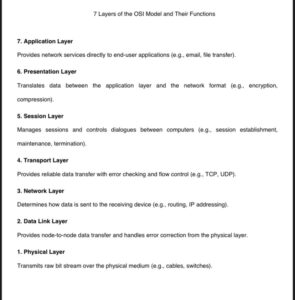7 Layers of the OSI Model and Their Functions:
Understanding the 7 Layers of the OSI Model and Their Functions
In the world of computer networking, the OSI Model (Open Systems Interconnection Model) is a foundational concept that helps us understand how different networking protocols interact and work together to allow communication between devices. This model divides the communication process into seven distinct layers, each with its own role and responsibilities.
Whether you’re a beginner in networking or just looking to brush up on the basics, understanding these layers is key. Let’s break them down one by one.
1. Physical Layer
Function:
The Physical Layer is the lowest layer of the OSI model and is responsible for the actual transmission of raw data bits over a physical medium. This includes cables, switches, electrical signals, and the hardware involved in moving data from one point to another.
Key responsibilities:
• Bit-by-bit data transmission
• Signal encoding
• Physical connections (e.g., cables, NICs)
2. Data Link Layer
Function:
The Data Link Layer handles the node-to-node transfer of data. It ensures that data sent from the physical layer is error-free and properly sequenced. It also manages MAC addresses and helps in error detection and correction.
Key responsibilities:
• Framing and addressing (MAC addresses)
• Error detection and correction
• Flow control
3. Network Layer
Function:
The Network Layer is responsible for routing, or deciding the best path for data to reach its destination. It deals with IP addressing and manages packet forwarding across networks.
Key responsibilities:
• Logical addressing (IP)
• Routing
• Packet forwarding
4. Transport Layer
Function:
This layer ensures that data is delivered error-free, in sequence, and with no losses or duplications. It handles both connection-oriented (TCP) and connectionless (UDP) communication.
Key responsibilities:
• Reliable data transfer
• Error recovery
• Flow control and segmentation
5. Session Layer
Function:
The Session Layer manages and controls the dialogue between two devices. It establishes, maintains, and ends sessions, making sure that data from different applications remain separate.
Key responsibilities:
• Session establishment and termination
• Synchronization
• Dialog control
6. Presentation Layer
Function:
Often referred to as the “translator” of the OSI model, this layer formats or translates data between the application and the network. It also handles encryption, decryption, and data compression.
Key responsibilities:
• Data translation
• Encryption and decryption
• Data compression
7. Application Layer
Function:
At the top of the OSI model, the Application Layer interacts directly with end-user applications. It provides services like email, file transfer, and web browsing.
Key responsibilities:
• Network services to applications
• User interface
• Protocols like HTTP, FTP, SMTP

Final Thoughts
The OSI Model is more than just a theoretical framework—it’s a tool for understanding and troubleshooting network issues. Each layer plays a critical role in ensuring that data flows smoothly and securely from one point to another. By understanding the purpose and function of each layer, network professionals and enthusiasts can better manage and design efficient communication systems.
